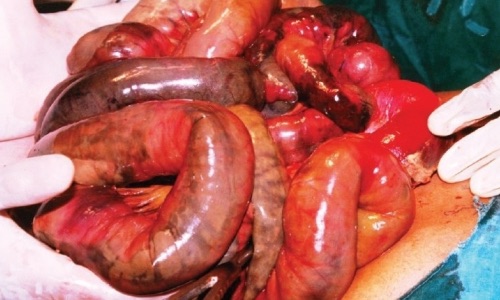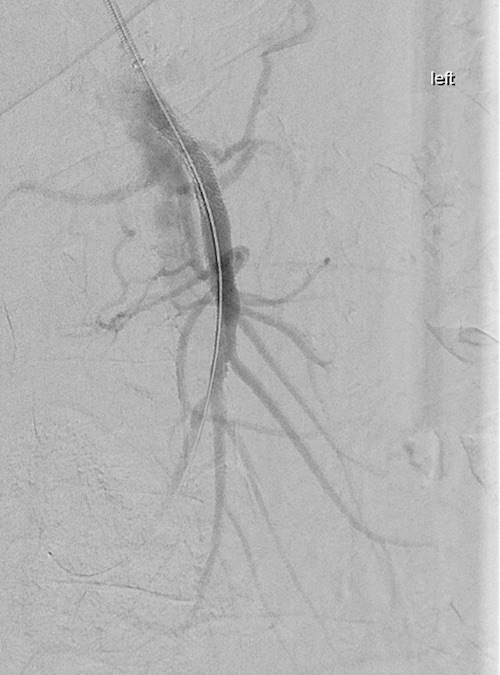Chronic Mesenteric Ischemia (CMI)
Victor Roman Steele, MD
The Operative Review of Surgery. 2023; 1:262-266.
Table of Contents
Definitions
Definitions
- Intestinal Ischemia: Inadequate Blood Supply to Meet Demands of Intestines
- Mesenteric Ischemia: Ischemia of the Small Intestine (Often Used Interchangeably with Intestinal Ischemia)
- Colonic Ischemia: Ischemia of the Large Intestine
- Splanchnic/Visceral Ischemia: A Broader Term to Describe Ischemia of the Intestine and Other Solid Organs (Liver, Kidney, Spleen)
Classification/Timing
- Acute Mesenteric Ischemia (AMI) – Rapid Onset Over Hours-Days
- Most Common Cause: Arterial Embolism
- *See Acute Mesenteric Ischemia (AMI)
- Chronic Mesenteric Ischemia (CMI) – Slow Onset Over Weeks-Months
- Also Known as “Abdominal Angina” 1
- Most Common Cause: Arterial Thrombosis/Atherosclerosis
Pathophysiology 2-4
- Becomes Symptomatic Once the Combined Primary and Collateral Perfusion is Inadequate to Meet the Postprandial Metabolic Demand
- Mesenteric Circulation Has a Rich Collateral System – Typically Become Symptomatic Only Once ≥ 2 Vessels (Celiac, SMA, or IMA) are Severely Stenosed or Occluded
- May Still Present Even if Only a Single Vessel is Involved (Especially the SMA)
- Mesenteric Artery Stenosis is a Common Finding at Autopsy (30-50%)
- The Majority are Asymptomatic and Rarely Develop Ischemia Due to Rich Collaterals
Etiology 3-5
- Atherosclerosis (90% – Most Common)
- Most Often Develop at the Origin as an Extension from an Aortic Plaque
- Often Have Concurrent Atherosclerosis Elsewhere
- Median Arcuate Ligament Syndrome (MALS)
- Vasculitis
- Arterial Dissection
- Fibromuscular Dysplasia
- Radiation Arteritis
- Mesenteric Venous Stenosis
- Drug-Induced Arteriopathy
Risk Factors 2,3,6
- Elderly
- Female (3:1)
- Smoking
- Hypertension
- Hyperlipidemia
Presentation and Diagnosis
Presentation 7,8
- Postprandial Abdominal Pain (“Intestinal Angina”) (90%)
- Starts 10-15 Minutes After Eating
- Can Last 5-6 Hours
- *May Have Altered Eating Habits and Not Report Abdominal Pain
- “Food Fear” (Sitophobia)
- Weight Loss (65%)
- Malnutrition and Cachexia
- Postprandial Nausea and Vomiting
- Postprandial Diarrhea
- Recurrent Peptic Ulcers
- At Risk for Developing an Acute Mesenteric Ischemia (Second Most Common Cause) 8,9
Diagnosis 8,10
- Physical Exam and Laboratory Evaluation are Nonspecific
- Screening: Mesenteric Duplex US
- Can Assess Celiac and SMA but the IMA is Difficult to Visualize
- Moneta Criteria Indicating ≥ 70% Stenosis: 11
- SMA Peak Systolic Velocity (PSV) ≥ 275 cm/s
- Celiac Peak Systolic Velocity (PSV) ≥ 200 cm/s
- Cutoff Values are Overall Poorly Defined
- Primary Diagnosis: CTA or MRA
- Also Allows Analysis of the Anatomy to Plan Treatment
- Angiography is the Defined “Gold Standard” Diagnostic Study
- Most Been Replaced by the Use of CTA/MRA for Actual Diagnosis
- Now Primarily Used in the Endovascular Treatment

Necrotic Bowel in Acute Mesenteric Ischemia 12

SMA Stenosis on CTA 13
Treatment
Indications for Revascularization 14,15
- All Symptomatic Patients
- Asymptomatic with Severe 3-Vessel Disease
Goals of Revascularization 16
- Resolve Symptoms
- Obtain a Normal Weight
- Prevent Development of Acute Mesenteric Ischemia and Bowel Necrosis
Approaches to Revascularization
- Often Require Preoperative Nutritional Optimization
- Percutaneous Transluminal Angioplasty (PTA) and Stenting
- The Preferred initial Approach for Suitable Lesions 14
- The SMA is Generally the Primary Target of Revascularization 14,16
- The Celiac Artery and IMA are Generally Considered Secondary Targets 14,16
- Open Revascularization/Bypass
- Indicated for Lower Operative Risk Groups if the Anatomy is Unfavorable 14
- Unfavorable Anatomy:
- Severe Eccentric Calcification
- Flush Occlusion of the Aorta
- Longer Occlusion
- Small Outflow Vessels
- Tandem Lesions Affecting the Branches
- Open Reconstructions are More Durable – Lower Rates of Restenosis, Symptom Recurrence, and Reintervention 17

Angiogram Showing Patent SMA After PTA/Stent 18
Open Revascularization and SMA Bypass
Revascularization Approach
- Antegrade Mesenteric Bypass
- Inflow from the Supraceliac Aorta
- Two-Vessel Antegrade Bypass Using a Bifurcated Prosthetic Conduit to Both the Celiac and SMA is the Most Common Open Reconstruction (> 80%) 16
- Can Be Performed Through Either a Transperitoneal or a Retroperitoneal Incision
- Other Approaches:
- Retrograde Mesenteric Bypass
- Inflow from the Infrarenal Aorta or Iliac Vessels)
- Preferred for Higher Risk Surgical Patients that Are Not Candidates for Supraceliac Aortic Procedures
- Hybrid Retrograde SMA Stent – Done from an Open Approach
- Endarterectomy – Rarely Indicated
- Retrograde Mesenteric Bypass
Graft Options
- Synthetic Graft (Dacron) – Generally Preferred
- Benefits:
- Better Patency
- Better Size Match
- Easier Handling
- Kink Resistant
- Avoid Additional Time Required for Vein Harvesting
- Generally Avoided in the Setting of Bowel Necrosis or Perforation
- Benefits:
- Autogenous Vein
- Preferred if Bowel is Necrosed or with Peritoneal Spillage
- Requires a Vein of Suitable Size and Quality – Most Commonly the GSV
- Higher Risk of Kinking and Requires Extra Time for Harvesting
References
- Goodman G.H.: Angina abdominis. Am J Med Sci 1918; 155: pp. 524-528.
- Bobadilla JL. Mesenteric ischemia. Surg Clin North Am. 2013 Aug;93(4):925-40, ix.
- Wilkins LR, Stone JR. Chronic mesenteric ischemia. Tech Vasc Interv Radiol. 2015 Mar;18(1):31-7.
- Terlouw LG, Moelker A, Abrahamsen J, Acosta S, Bakker OJ, Baumgartner I, Boyer L, Corcos O, van Dijk LJ, Duran M, Geelkerken RH, Illuminati G, Jackson RW, Kärkkäinen JM, Kolkman JJ, Lönn L, Mazzei MA, Nuzzo A, Pecoraro F, Raupach J, Verhagen HJ, Zech CJ, van Noord D, Bruno MJ. European guidelines on chronic mesenteric ischaemia – joint United European Gastroenterology, European Association for Gastroenterology, Endoscopy and Nutrition, European Society of Gastrointestinal and Abdominal Radiology, Netherlands Association of Hepatogastroenterologists, Hellenic Society of Gastroenterology, Cardiovascular and Interventional Radiological Society of Europe, and Dutch Mesenteric Ischemia Study group clinical guidelines on the diagnosis and treatment of patients with chronic mesenteric ischaemia. United European Gastroenterol J. 2020 May;8(4):371-395.
- Zeller T, Rastan A, Sixt S. Chronic atherosclerotic mesenteric ischemia (CMI). Vasc Med. 2010 Aug;15(4):333-8.
- Moawad J, Gewertz BL. Chronic mesenteric ischemia. Clinical presentation and diagnosis. Surg Clin North Am. 1997 Apr;77(2):357-69.
- Atkins M.D., Kwolek C.J., LaMuraglia G.M., et. al.: Surgical revascularization versus endovascular therapy for chronic mesenteric ischemia: a comparative experience. J Vasc Surg 2007; 45: pp. 1162-1171.
- Gnanapandithan K, Feuerstadt P. Review Article: Mesenteric Ischemia. Curr Gastroenterol Rep. 2020 Mar 17;22(4):17.
- Bala M, Kashuk J, Moore EE, Kluger Y, Biffl W, Gomes CA, Ben-Ishay O, Rubinstein C, Balogh ZJ, Civil I, Coccolini F, Leppaniemi A, Peitzman A, Ansaloni L, Sugrue M, Sartelli M, Di Saverio S, Fraga GP, Catena F. Acute mesenteric ischemia: guidelines of the World Society of Emergency Surgery. World J Emerg Surg. 2017 Aug 7;12:38.
- Sardar P, White CJ. Chronic mesenteric ischemia: Diagnosis and management. Prog Cardiovasc Dis. 2021 Mar-Apr;65:71-75.
- Moneta GL, Yeager RA, Dalman R, Antonovic R, Hall LD, Porter JM. Duplex ultrasound criteria for diagnosis of splanchnic artery stenosis or occlusion. J Vasc Surg. 1991 Oct;14(4):511-8; discussion 518-20.
- Zachariah SK. Adult necrotizing enterocolitis and non occlusive mesenteric ischemia. J Emerg Trauma Shock. 2011 Jul;4(3):430-2. (License: CC BY-NC-SA 3.0)
- Reginelli A, Genovese E, Cappabianca S, Iacobellis F, Berritto D, Fonio P, Coppolino F, Grassi R. Intestinal Ischemia: US-CT findings correlations. Crit Ultrasound J. 2013 Jul 15;5 Suppl 1(Suppl 1):S7. (License: CC BY 2.0)
- Huber T.S., Bjorck M., Chandra A., et. al.: Chronic mesenteric ischemia: Clinical practice guidelines from the Society for Vascular Surgery. J Vasc Surg 2021; 73: pp. 87S-115S.
- Thomas J.H., Blake K., Pierce G.E., et. al.: The clinical course of asymptomatic mesenteric arterial stenosis. J Vasc Surg 1998; 27: pp. 840-844.
- Conrad MF. Chronic Mesenteric Ischemia: Epidemiology, Pathophysiology, Clinical Evaluation, and Management. In: Rutherford’s Vascular Surgery and Endovascular Therapy, 10e. Elsevier. 2023.
- van Petersen A.S., Kolkman J.J., Beuk R.J., et. al.: Open or percutaneous revascularization for chronic splanchnic syndrome. J Vasc Surg 2010; 51: pp. 1309-1316.
- Barasa A, Bader G. Chronic Mesenteric Ischemia in a Patient With Limited Systemic Sclerosis. Cureus. 2023 Jan 25;15(1):e34209. (License: CC BY)